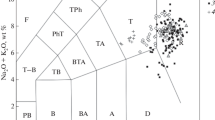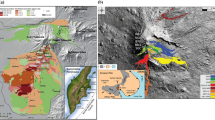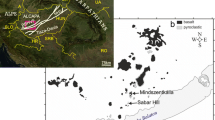Abstract
Experiments were conducted on a natural basalt (with 5 wt.% added H2O) at 1.0–2.5 GPa and 900–1100°C. Experimental products include partial melts (quenched glasses) + residual mineral assemblages of amphibolite or eclogite. Electron microprobe and LAM-ICP-MS were used to determine major and trace element compositions of these quenched melts, respectively. Major element compositions of all the melts are tonalitic-trondhjemitic, similar to adakite. Their trace element characteristics are controlled by coexisting residual minerals. Signatures of adakite such as high Sr/Y, low HREE and negative Nb-Ta anomaly, etc. are present only in the melts coexisting with residual assemblages containing rutile and garnet (rutile-bearing eclogite or rutile-bearing amphibole-eclogite). Garnet leads to HREE depletion in melts, whereas rutile controls Nb and Ta partitioning during the partial melting and causes negative Nb-Ta anomaly in melts. Therefore, in addition to garnet, rutile is also a necessary residual phase during the generation of adakite or TTG magmas to account for the negative Nb-Ta anomaly of the magmas. The depth for the generation of adakite/TTG magmas via melting of metabasalt must be more than about 50 km based on the approximate 1.5 GPa minimum-pressure for rutile stability in the partial melting field of hydrous basalt.
Similar content being viewed by others
References
Xiong X L, Adam J, Green T H. Rutile stability and rutile/melt HFSE partitioning during partial melting of hydrous basalt: Implications for TTG genesis. Chem Geol, 2005, 218: 339–359
Defant M J, Drummond M S. Derivation of some modern arc magmas by melting of young subducted lithosphere. Nature, 1990, 347: 662–665
Drummond M S, Defant M J, Kepezhinskas P K. Petrogenesis of slab-derived trondhjemite-tonalite-dacite/adakite magmas. Trans Royal Soc Edinburgh. Earth Sci, 1996, 87: 205–215
Martin H. Adakitic magmas: modern analogues of Archean granitoids. Lithos, 1999, 46: 411–429
Zhang Q, Wang Y, Qian Q, et al. The characteristics and tectonic-metallogenic significance of the adakites in Yanshan Period from eastern China. Acta Petrol Sin (in Chinese with English abstract), 2001, 17(2): 236–244
Xu J F, Shinjo R, Defant M J, et al. Origin of Mesozoic adakitic intrusive rocks in the Ningzhen area of east China: Partial melting of delaminated lower continental crust? Geology, 2002, 30: 1111–1114
Wang Q, Xu J F, Zhao Z H. Intermediate-acid igneous rocks strongly depleted in heavy rare earth elements (or adakitic rocks) and copper-gold metallogenesis. Earth Sci Front (in Chinese with English abstract), 2003, 10(4): 561–572
Xiong X L, Li X H, Xu J F, et al. Extremely high Na adakite-like magmas derived from lower crust basaltic underplate: the Zhantang andesitc rocks from Huichang Basin, SE China. Geochem J, 2003, 37: 233–252
Xiong X L, Zhao Z H. Adakite-type sodium-rich rocks in Awulale Mountain of west Tianshan: Significance for the vertical growth of continental crust. Chin Sci Bull, 2001, 46(7): 811–817
Gao S, Rudnick R L, Yuan H L, et al. Recycling lower continental crust in the North China craton. Nature, 2004, 432: 892–897
Green T H. Anatexis of mafic crust and high pressure crystallization of andesite. In: Thorpe R S. New York: Andesites John Wiley, 1982, 465–487
Rapp R P, Watson E B, Miller C F. Partial melting of amphibolite/eclogite and the origin of Archean trondhjemites and tonalities. Precam Res, 1991, 51: 1–25
Rapp R P. Watson E B. Dehydration melting of metabasalt at 8–32 kbar implications for continental growth and crust-mantle recycling. J Petrol, 1995, 36: 891–931
Sen C, Dunn T. Dehydration melting of a basaltic composition amphibolite at 1.5 and 2.0 GPa: implications for the origin of adakites. Contrib Mineral Petrol, 1994, 117: 394–409
Winther K T. An experimentally-based model for the origin of tonalitic and trondhjemitic melts. Chem Geol, 1996, 127: 43–59
Liu J, Bohlen S R, Ernst W G. Stability of hydrous phases in subducting oceanic crust. Earth Planet Sci Lett, 1996, 143: 161–171
Prouteau G, Scaillet B, Pichavent M, et al. Evidence for mantle metasomatism by hydrous silicic melts derived from subducted oceanic crust. Nature, 2001, 410: 197–200
Rapp R P, Shimizu M D, Norman G S, et al. Reaction between slab-derived melts and peridotite in the mantle wedge: experimental constraints at 3.8 GPa. Chem Geol, 1999, 160: 335–356
Foley S F, Tiepolo M, Vannucci R. Growth of early continental crust controlled by melting of amphibolite in subduction zones. Nature, 2002, 417: 837–840
Rapp R P, Shimizu N, Norman M D. Growth of early continental crust by partial melting of eclogite. Nature, 2003, 425: 605–609
Hofmann A W. Chemical differentiation of the Earth: the relationship between mantle, continental crust, and oceanic crust. Earth Planet Sci Lett, 1988, 90: 297–314
Green D H. Experimental testing of ‘equilibrium’ partial melting of peridotite under water-saturated, high-pressure conditions. Can Mineral, 1976, 14: 155–168
Parkinson I J, Arculus R J. The redox state of subduction zones: insights from arc-peridotites. Chem Geol, 1999, 160: 409–423
Pouchou J I, Pichoir F. A new model for quantitative X-ray microanalysis: Part I. Application to the analysis of homogeneous samples. Rech Aerosp, 1984, 3: 13–38
Green T H, Adam J. Experimentally-determined trace element characteristics of aqueous fluid from partially dehydrated mafic oceanic crust at 3.0 GPa, 650–700°C. Eur J Mineral, 2003, 15: 815–830
Beard J S, Lofgren G E. Dehydration melting and water-saturated melting of basaltic and andesitic greenstones and amphibolites at 1, 3, 6.9 kbar. J Petrol, 1991, 32: 365–401
Gutscher M A, Muary R C, Eissen J P, et al. Can slab melting be caused by flat subduction? Geology, 2000, 28: 535–538
Yogodzinski G M, Less J M, Churikova T G, et al. Geochemical evidence for the melting of subducting oceanic lithosphere at plate edges. Nature, 2001, 409: 500–504
Prouteau G, Scaillet B, Pichavant M, et al. Fluid-present melting of ocean crust in subduction zones. Geology, 1999, 27: 1111–1114
Defant M J, Richerson P M, De Boer J Z, et al. Dacite genesis via both slab melting and differentiation: petrogenesis of La Yeguada Volcanic Complex, Panama. J Petrol, 1991, 32: 1143–1167
Defant M J, Xu J F, Kepezhinskas P, et al. Adakites: some variations on a theme. Acta Petrol Sin, 2002, 18: 129–142
Smithies R H. The Archaean tonalite-trondhjemite-granodiorite (TTG) series is not an analogue of Cenozoic adakite. Earth Planet Sci Lett, 2000, 182: 115–125
Tiepolo M, Vannucci R, Oberti R, et al. Nb and Ta incorporation and fractionation in titanian pargasite and kaersutite: crystal-chemical constraints and implications for natural systems. Earth Planet Sci Lett, 2001, 176: 185–201
Niu Y, Batiza R. Trace element evidence from seamounts for recycled oceanic crust in the Eastern Pacific mantle. Earth Planet Sci Lett, 1997, 148: 471–483
Weyer S, Munker C, Mezger K. Nb/Ta Zr/Hf and REEs in the depleted mantle: implications for the differentiation history of the crust-mantle system. Earth Planet Sci Lett, 2003, 205: 309–324
Green T H. Experimental studies of trace element partitioning applicable to igneous petrogenesis—Sedona 16 years later. Chem Geol, 1994, 117: 1–36
Adam J, Green T H, Sie S H. Proton microprobe determined partitioning of Rb, Sr, Ba, Y, Zr, Nb and Ta between experimentally produced amphiboles and silicate melts with variable F content. Chem Geol, 1993, 109: 29–49
Brenan J M, Shaw H F, Ryerson F J, et al. Experimental determination of trace-element partitioning between pargasite and a synthetic hydrous andesitic melt. Earth Planet Sci Lett, 1995, 135: 1–11
Klein M, Stosch H, Seck H A. Partitioning of high-field-strength and rare-earth elements between amphibole and quartz-dioritic to tonalitic melts: an experimental study. Chem Geol, 1997, 138: 257–271
Foley S F, Barth M G, Jenner G A. Rutile/melt partition coefficients for trace elements and assessment of the influence of rutile on the trace element characteristics of subduction zone magmas. Geochim Cosmochim Acta, 2000, 64: 933–938
Schmidt MW, Dardon A, Chazot G, et al. The dependence of Nb and Ta rutile-melt partitioning on melt composition and Nb/Ta fractionation during subduction processes. Earth Planet Sci Lett, 2004, 226: 415–432
Stalder R, Foley S F, Brey G P, Horn I. Mineral-aqueou fluid partitioning of trace elements at 900–1200 °C and 3.0–5.7 GPa: New experimental data for garnet, clinopyroxene, and rutile, and implications for mantle metasomatism. Geochim Cosmochim Acta, 1998, 62: 1781–1801
Keppler H. Constraints from partitioning experiments on the composition of subduction zone fluids. Nature, 1996, 380: 237–240
Author information
Authors and Affiliations
Corresponding author
Rights and permissions
About this article
Cite this article
Xiong, X., Adam, J., Green, T.H. et al. Trace element characteristics of partial melts produced by melting of metabasalts at high pressures: Constraints on the formation condition of adakitic melts. SCI CHINA SER D 49, 915–925 (2006). https://doi.org/10.1007/s11430-006-0915-2
Received:
Accepted:
Issue Date:
DOI: https://doi.org/10.1007/s11430-006-0915-2




